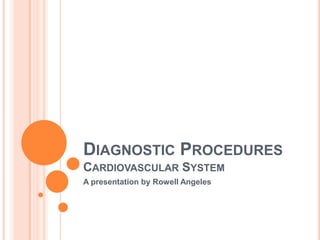Cardiac catheterization is a procedure that inserts a catheter into the heart to evaluate heart function and disease. It can diagnose conditions like coronary artery disease and determine if treatments like angioplasty are needed. The catheter is inserted into an artery and guided to the heart where contrast dye is injected to image the heart and arteries. An electrocardiogram (ECG) records the heart's electrical activity through electrodes on the skin to check for issues like heart attacks or abnormal rhythms. A computed tomography (CT) scan uses x-rays to create clear pictures of the heart and assess conditions like tumors without invasive procedures.














